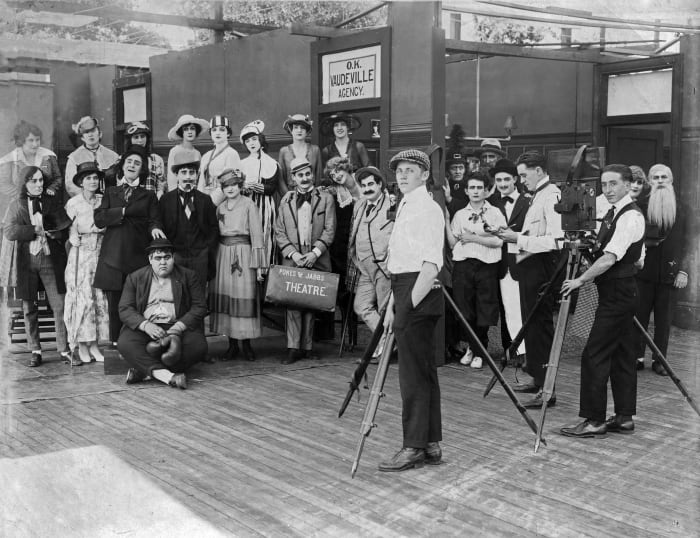
Lights, Camera, Action! Jacksonville was America’s first Hollywood
JACKSONVILLE, Fla. – These days Hollywood is the movie-making capital of the world. But had LA not lured filmmakers to go west, we might be hearing “Lights, Camera, Action!” in Jacksonville, and the River City could have been the film-making capital of the world.
We know what our modern-day Jacksonville skyline looks like. Let your mind wander a bit and travel back in time. In the early 1900s, there were TV production studios right here in the River City.
Back in the day, silent film stars could be seen strolling down Main Street. All of a sudden crowds would gather to watch. They would encounter stars like Babe Hardy. He started his motion picture career in Jacksonville in 1914. Among the other silent film stars who made movies in Jacksonville are Rudolph Valentino and Lionel and Ethel Barrymore.
It was mainly independent filmmakers who flocked to Jacksonville. They came here because of the climate, exotic locations, architecture and rail access.
Ad
“Well, Jacksonville became really what was known as the winter film capital of the world,” said Jim Kerkhoff, a film historian. “And this happened around 1908. Most of the production back in 1908 was done up in the New York/New Jersey area.
“What was happening, though, in the wintertime, they were out of luck. It was cold. That created problems with the cameras. The film stock would freeze up, fog up. So there was a direct rail line that came from New York down to Jacksonville because that carried vacationers, wealthy vacationers, down to the area. And somebody thought, well, let’s do some filming down there, in terms of being able to shoot year-round,” Kerkhoff said.
In 1920 Richard Norman was producing films. Norman, who was white, didn’t like the way Black actors were always portrayed in subservient roles. He wanted to change that. So when he moved to Jacksonville and established his studio in Jacksonville he produced a movie in 1926, “The Flying Ace.” It employed an all-African-American cast and was shown specifically to African-American audiences.
Ad
“He believed that people ought to be treated right,” said Rita Reagan, executive director of Norman Studios. “And they ought to be portrayed correctly.
“Some of the movies that were made by the companies that were here in Jacksonville, I won’t mention the names of you know, they were so awful. And he hated that. And he thought that he could make something that would portray African Americans as they really were. And not as you know, some racists saw them — the stereotypes,” said Reagan.
The film was made in Jacksonville at the site where Norman Studios is being refurbished for history’s sake. And the plane taxied right through an area past what was then the wardrobe building off what is now a residential site off Arlington Avenue, blocks from the bustling Arlington Expressway.
“The wardrobe cottage was where many of the people who came to be in Richard’s movies would actually stay,” said Reagan. “If they were a married couple, they’d stay there if they were to singles because he always brought stars to towns as in to be in his movies. And sometimes they stay one or the other would stay with the family upstairs on the second floor. That building has had a lot of history.”
Ad
Norman Studios made movies here for about 10 years but when the silent era ended, it never made the transition to “talkies.”
So why did Jacksonville lose out on being Hollywood East? Well, it seems the residents who lived here at the time were characterized as being rather conservative.
“What happened was, essentially, Jacksonville really was a hub of production for many, many years, a lot of activity here, the motion picture people sort of wore out their welcome,” Kerkhoff said. “Because what they would do would be they do stunts where they’d call in a false fire alarm, set up a camera across from the fire station to get the racing engine out of the garage. There was one infamous one where one of the production companies staged a mob scene downtown. And it got out of control and it actually turned into a mob. And they’re breaking storefront windows and that kind of thing. That didn’t go over well. Plus, they would shoot they would go into areas of town on Sunday when everybody else is in church.”
Ad
Consequently, the filmmaking industry in Jacksonville dwindled. You also had a mayor who took office who didn’t take kindly to the movie makers. An influenza epidemic in 1918 didn’t help, nor did World War I.
Then there was Hollywood’s glamour. All that proved too much for Jacksonville.
While there is some filmmaking that still goes on in the area, Jacksonville never regained its former glory nor became Hollywood East as had been hoped back in the early 1900s.
Copyright 2022 by WJXT News4JAX – All rights reserved.
